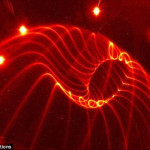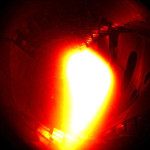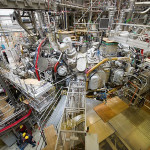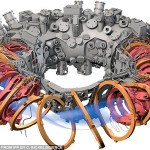
WHY THIS MATTERS IN BRIEF
Nuclear fusion holds the promise of being able to help humanity harness limitless, clean energy but until now scientists have had problems containing and stabilising the plasma flows needed to fuel the final energy producing reactions.
Last year in Germany a new type of massive nuclear fusion reactor was turned on. It had taken nineteen years to build and the teams involved were hoping for nothing less than the opportunity to re-create, as they put it “a piece of the Sun. In december last year the machine managed to contain a blob of helium plasma that was heated to one million degrees celcius and travelling at 700mph but since then, however, we’ve all been left to wonder if it’s been working as advertised – after all, the promise of limitless, clean energy is a big deal but first we need a machine that can maintain and control the insane nuclear fusion reactions.
Now the team of researchers from the US and Germany have now confirmed that the Wendelstein 7-X (W 7-X) stellerator is producing the super strong, twisty, 3D magnetic fields that its design predicted with “unprecedented accuracy”. The researchers found an error rate less than one in 100,000.
“To our knowledge, this is an unprecedented accuracy, both in terms of the as-built engineering of a fusion device, as well as in the measurement of magnetic topology,” said the team.
That might not sound exciting, but it’s crucial, because that magnetic field is the only thing that will trap hot balls of plasma long enough for nuclear fusion to occur.
Nuclear fusion is one of the most promising sources of clean energy out there – with little more than salt water, it offers limitless energy using the same reaction that powers our Sun.
Unlike nuclear fission, however, which is achieved by our current nuclear plants, and involves splitting the nucleus of an atom into smaller neutrons and nuclei, nuclear fusion generates huge amounts of energy when atoms are fused together at incredibly high temperatures. And it produces no radioactive waste or other byproducts.
Based on the longevity of our Sun, nuclear fusion also has the potential to supply humanity with energy for as long as we need it – if we can figure out how to harness the reaction, that is.
And that’s a pretty big ‘if’, because scientists have been working on the problem for more than 60 years, and we’re still a fair way off our goal.
The main challenge is that, in order to achieve controlled nuclear fusion, we have to actually recreate conditions inside the Sun and that means building a machine that’s capable of producing and controlling a 100 million degree Celsius (180 million degree Fahrenheit) ball of plasma gas, and as you can imagine, that’s easier said than done. But there are several nuclear fusion reactor designs in operation around the world right now that are trying their best, and the W 7-X is one of the most promising attempts.
Instead of trying to control plasma with just a 2D magnetic field, which is the approach used by the more common Tokamak reactors, the stellerator works by generating twisted, 3D magnetic fields.
This allows stellerators to control plasma without the need for any electrical current – which tokamaks rely on – and as a result, it makes stellerators more stable, because they can keep going even if the internal current is interrupted.
Well, that was the idea of its design, at least.
Despite the fact that the machine successfully controlled helium plasma in December last year, and then the more challenging hydrogen plasma in February, no one had shown that the magnetic field was actually working as it should be.
To measure it, a team of researchers from the US Department of Energy and the Max Planck Institute of Plasma Physics in Germany sent an electron beam along the magnetic field lines in the reactor.
Using a fluorescent rod, they swept through those lines and created light in the shape of the fields. The result, which you can see in the image above, shows the exact type of twisted magnetic fields that it was supposed to make.
“We’ve confirmed that the magnetic cage that we’ve built works as designed,” said one of the lead researchers, Sam Lazerson from the US Department of Energy’s Princeton Plasma Physics Laboratory.
Despite this success, W 7-X isn’t actually intended to generate electricity from nuclear fusion – it’s simply a proof of concept to show that it could work.
In 2019, the reactor will begin to use deuterium instead of hydrogen to produce actual fusion reactions inside the machine, but it won’t be capable of generating more energy than it current requires to run.
That’s something that the next-generation of stellerators will hopefully overcome.
“The task has just started,” said the team.





















Amazing accuracy. Gives great hope for clean energy.